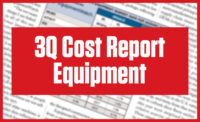At the onset of the COVID-19 pandemic in the U.S., equipment makers and distributors were in a good place. There had been some talk about the construction cycle peaking in 2020 and perhaps cooling off, but sales were strong and backlogs among contractors remained healthy. But as the pandemic stretches on, the effects of construction shutdowns, collapses in state and local revenues and a pullback in private construction have equipment manufacturers, distributors and suppliers facing tough choices.
Largely classified as an essential service, construction has kept going in most U.S. states and cities through the pandemic, but new projects are being delayed and preconstruction work has slowed on others. Bids are drying up, and with thinner backlogs, contractors and fleet managers are buying less iron.
Yet while orders for new construction equipment steeply declined in the second quarter, the outlook is not entirely grim. In midyear reports and second quarter earnings statements, equipment makers were unified in their efforts to soften the blow of the pandemic and focus on what comes next.
“I am proud of the global team’s continued focus on safety while executing our strategy and serving our customers,” said Caterpillar chairman and CEO Jim Umpleby in the company’s 2Q earnings report. “In the second quarter, our employees and dealers remained dedicated to providing the essential products and services the world needs under very challenging conditions.” Caterpillar reported a 31% year-over-year drop in second quarter sales and revenue, with its dealers reporting a decrease in machine and engine inventories of about $1.4 billion, compared to an increase of $500 million during the same period last year.
“Our employees and dealers remained dedicated to providing the essential products and services the world needs under very challenging conditions.”
– Jim Umpleby, Chairman and CEO, Caterpillar
Caterpillar was hardly alone in seeing a fall in sales due to the COVID-19 pandemic. Japan-based Komatsu reported a drop in year-over-year global sales of 25%, driven by the substantial collapse in sales in North America, Europe and Asia outside of China. Comparing the decline in demand for new machines to the 2008 financial crisis, Komatsu chairman and CEO Hiroyuki Ogawa said the company has seen a drop in demand of 30%, compared to 40% in 2008. “In China, the spread of the virus has already subsided, and demand has recovered in the market. But for other strategic markets, apart from China, there are still regions where infections are spreading, and the demand outlook is uncertain,” Ogawa said in a July 30 earnings call. But he added that data from Komatsu’s KOMTRAX telematics system shows that overall machine usage has already returned to pre-COVID-19 levels, whereas it took nearly two years for operating levels to recover after the 2008 financial crisis.
At Terex—whose Genie aerial work platform line saw a 52% drop in global sales in Q2—an initial plummet in sales at the start of the pandemic has leveled off, according to CEO John Garrison. “2Q sales have stabilized, but we are below pre COVID-19 levels,” he said on a July 31 quarterly earnings call.
The wipeout of construction equipment’s rosy outlook for 2020 goes well beyond the big players, according to surveys conducted by the Association of Equipment Manufacturers.
“Things were looking pretty strong, then COVID hit. It didn’t take long for that backlog to completely vanish,” observes Kip Eideberg, AEM senior vice president for government and industrial relations. “Orders for new equipment started to dry up, and while some of that has rebounded since, there’s no doubt COVID-19 has taken a toll on the industry.”
But while most major equipment manufacturers have been able to at least partially resume production at their facilities in the U.S. and abroad, possible constrictions in the supply chain, particularly from smaller domestic suppliers, could lead to bottlenecks for manufacturing capacity into 2021.
AEM’s surveys found that concern is high among mid-sized and smaller manufacturers about their domestic suppliers surviving long enough to see a recovery in demand. “What I worry about is the rest of the year into 2021,” says Eideberg. “When the economic recovery hits and gets roaring again, it does us no good if companies can’t get enough parts and components to meet increased demand.”
Clean the Machines
With the pandemic still very much not under control in the U.S., equipment companies are taking steps to maintain safety for workers and equipment operators during deliveries and handoffs. New procedures for wiping down equipment and social distancing during repair visits and other interactions have become standard procedure, yet another layer of work on already busy construction sites.
Machines often pass from operator to operator as needed on jobsites, and swing shifts can keep them in production 24/7. Most manufacturers in the U.S. defer to the CDC and OSHA for how to safely run and transport equipment during the pandemic. But a few, including Caterpillar, issued their own extra recommendations for properly disinfecting equipment cabs, sending the guidelines out to dealers and operators in March.
“In terms of the effectiveness of killing the virus, we wanted to provide reasonable steps to meet CDC guidelines,” says Matt Harrenstein, engineering manager for Cat’s building products group, who oversaw development of the cab disinfection guidelines.
“We give customers masks, have outdoor handwashing stations and have our people make sure visitors don’t congregate.”
– Kevin Kobus, Ritchie Bros. Vice President of Operations, U.S. and Mexico
Since Cat needs to make the guide globally useful, it avoids recommending any specific products, instead focusing on general tips to clean contact surfaces in cabs between uses. “There are certain chemicals that have negative effects on some materials we use in the cab,” he says. “We didn’t want to allow for an unsafe condition.”
Cat recommends using soap, isopropyl alcohol or non-bleach disinfectants to clean surfaces in cabs, as bleach and solvents can damage the interior components. This includes the numerous touchscreens found in modern equipment cabs, which Harrenstein says can be disinfected in the same way as any smartphone.
“Using wipes and wiping down cabs after function time is key,” he says. “Not leaving residue on contact surfaces was one of key things we wanted to get across.”
For equipment firms that rely on in-person interactions, the pandemic has accelerated a shift to online processing and contactless handoffs. Auctioneer Ritchie Bros. has sidelined its huge in-person auctions of used equipment in favor of pushing online-only bidding. But even equipment drop-offs and inspections at Ritchie Bros. events in the North America have required new procedures during COVID-19.
“When we receive equipment, we sanitize it—the cabs in particular,” says Kevin Kobus, Ritchie Bros. vice president of operations for U.S. and Mexico. “We’ve also suspended some of our policies to let us avoid contact with truck drivers—so no more cash payments—and are scheduling drop-offs to avoid too many people there at once.” While Ritchie Bros. had already seen more than half of its bidding volume shift to online before COVID-19, there are still bidders who want to come to the yard and kick the tires during the pandemic. “We give customers masks, have outdoor handwashing stations and have our people make sure visitors don’t congregate,” he says. But on bid days, the auction theaters are closed and all bids are now submitted online, he adds.
Ritchie Bros. has remained very busy during the pandemic. Uncertainty about construction demand going forward can be seen in the used equipment market. Contractors unsure about their future bids are looking to short-term arrangements like auctions for the equipment to meet their existing backlogs, says Kari Taylor, Ritchie Bros. president for North American sales. “In terms of sales we are seeing record demand … and a driver has been strong pricing.”
According to a Ritchie Bros. market report published in July, used heavy equipment prices have recovered from a dip in the spring, down only about 2% from 2019.
Perhaps most surprising is the kind of customer showing up for equipment auctions. Taylor says Ritchie Bros. is seeing a marked increase in the proportion of end users bidding on used construction equipment, rather than equipment brokers or other intermediaries.
Taylor says this could reflect a trend among contractors who are buying used equipment as needed for current projects, rather than going through their usual channels. “End users could be thinking more project-by-project, rather than planning out a fleet strategy for the next ten years,” she says. “It’s a much more myopic view than normal: ‘I need to finish the project down the street for the next six months. Why not get the dozer, backhoe or dump truck [at auction] from Ritchie Bros. and then put it up for auction later?’ ”
Running Out of Time
As the COVID-19 pandemic drags on in the U.S., the ill effects on the equipment manufacturing sector are forecast to worsen.
While some short-term help for smaller manufacturers and suppliers has come in the form of the Paycheck Protection Act and other aid in federal pandemic legislation, these policies are not a substitute for real demand, says AEM’s Kip Eideberg. “Right now we have smaller member companies running out of time and money, struggling to keep lights on and keep employees on the shop floor.”
“Right now we have member companies running out of time and money, struggling to keep lights on and keep employees on the shop floor.”
– Kip Eideberg, AEM Senior Vice President, Government
According to AEM surveys this summer of its members, Eideberg says that of the equipment manufacturers that furloughed employees, a third will not be bringing them back. And of those manufacturers that laid off employees due to the pandemic, four out of five would not bring them back under the current market conditions.
Temporary relief is critical for keeping the smaller players alive and domestic supply chains from withering away, but without serious spending on public construction, equipment makers will be in a tough bind, says Eideberg.
Infrastructure spending, initially on the table in legislation at the federal level but shelved earlier this spring, is one driver that Eideberg points to that would help equipment manufacturers get through this crisis.
‘‘We are not looking for handouts. What we want is for real demand for equipment to pick back up,” says Eideberg. “If the federal government could step in and fill that funding gap for state and local governments, and also authorize a long-term transportation program, that would give us some long-term certainty.”








Post a comment to this article
Report Abusive Comment